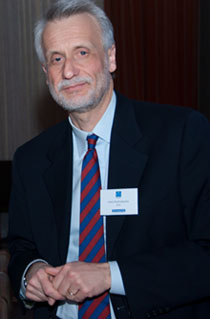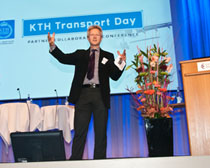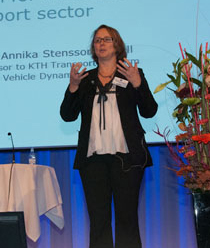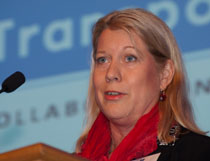Transport Day: Building Bridges from Research to Government & Industry
The KTH Transport Day – Partner Collaboration Conference on November 30 brought together some 300 participants to build partnerships and learn how today’s transportation research aims to meet coming challenges in society’s seemingly bottomless demand for efficient movement of people and goods. KTH Transport Day focusses on building bridges between the university’s world-class researchers and the companies, planners and governmental agencies working to shape transportation systems for the future.

Held at the Norra Latin conference centre in downtown Stockholm, Transport Day was opened by Professor Haris Koutsopoulos, Director of the KTH Transport Research Platform, with an overview of Platform’s mission of delivering multidisciplinary research for solutions that will service the society of tomorrow. Underlining that message was a day-long exhibit of 24 posters, with researchers on-hand describing their projects in an illustration of the university’s depth and breadth in the field.
Thirty presentations by KTH professors and graduate students gave a broad outline of transportation research at the university and in conjunction with partners, including:
- Sustainable Vehicle Technology
- Clean, Safe & Silent Air Traffic
- Sustainable Infrastructure
- Sustainable Cities
- Green Corridors
- Seamless Transport Systems
- Reliable Transport Systems

Fölster: "Experiment more"
Stefan Fölster, Chief Economist at the Confederation of Swedish Enterprise, described how a country’s approach to transportation can promote or hinder economic growth, noting that Switzerland invests about twice as much in infrastructure as Sweden, and that Sweden’s rate of investment in infrastructure is decreasing compared to the EU average.
“We need to adopt an experimental strategy for transport policy and research,” Fölster said. “We need to experiment on a larger scale so that we can measure and learn.”
Finnveden: "Get the prices right"
Professor Göran Finnveden, KTH Vice President for Sustainable Development, talked about the environmental and social challenges facing the transport sector around the world. “Globally, transport accounts for about 23 percent of energy-related greenhouse gas emissions,” he noted.
But the picture isn’t uniformly bleak, Finnveden said, explaining how carbon dioxide emissions can be reduced through a variety of approaches:
- Improved vehicle fuel efficiency
- Electric vehicles
- Low carbon fuels
- Modal shift to public transport
- Modal shift to freight rail
- Activity reduction.
“We need to continue to support technological development,” Finnveden said. “And we have to get the prices right to enable these modal shifts. Finally, long-term investments need to be in line with long-term goals.”

Stensson Trigell: Innovation in Transport
Professor Annika Stensson Trigell, head of the Division of Vehicle Dynamics at KTH, presented the new initiative “Forum for Innovation in the Transport Sector,” created to establish common strategies across Sweden, to initiate infrastructure projects and to promote dialogue and knowledge sharing among stakeholders.
The Forum is also intended to contribute to EU policy development and research agendas, while promoting domestic Swedish involvement in international networks working to strengthen national and European competitiveness.
Gudmundson announces Scania agreement
KTH President Peter Gudmundson highlighted the importance of transport research for KTH. “The strength of KTH is that we are broad, with expertise ranging from core engineering to social science,” he said.

President Gudmundson noted the creation in September of the new centre “Future Roads and Rails” (Bana Väg För Framtiden), to be operated by KTH, the Swedish Road Administration (Trafikverket) and VTI, The Swedish National Road and Transport Research Institute with initial funding of SEK 250 million ($36.1 million). Together with Stockholm University and Karolinska Institute, KTH is in discussions with the agencies about the possibility of the three universities jointly hosting a Transport Science Centre in Stockholm.
President Gudmundson also announced the signing of an agreement with the Swedish heavy vehicle manufacturer Scania CV AB for long-term research co-operation and exchanges of personnel.

Elmsäter-Svärd: Refine what we already have
Swedish Minister for Infrastructure Catharina Elmsäter-Svärd spotlighted the government’s focus on improving efficiency. “We need to refine what we already have,” she explained. “A good example of why we need to do that is that every second train operating in the EU is running empty. The government has set a goal of a fossil-free vehicle fleet by 2030 in Sweden, and this should be seen as a driver for new innovations.
“The KTH Transport Platform is an important national resource,” Elmsäter-Svärd continued. “Sweden needs close collaboration between governmental agencies and universities.”
Kevin Billinghurst & Mikael Nybacka
